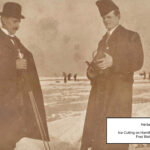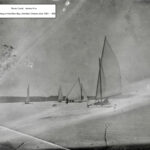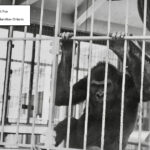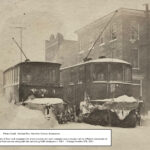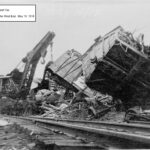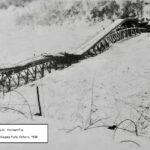
As early as 1904/1906, Herbert joined the local camera club and installed a dark room in his house on Gibson Avenue to process his images. Because the club would set up together at one location and take photographs of the same subject that was popular at the time, a few of Herbert's photos are identical to other images featured in published historic books and websites about Hamilton.
It was the summer of 2000. Dorothy had fed us lunch and was preparing to show us some things of the past. We were her grandkids and on our way with careers in far away places. The rare visits to our grandma as young adults were just as new an occurrence as they were diminishing, and perhaps it was under these circumstances that led Dorothy to bring a shoebox of Pappy's photos to the dining room table.
"I want to show you some old photos my father took," she began, hesitantly in nervous anticipation, her fingers fumbling a little to extract the first picture, "they're quite remarkable, taken a long time ago in Hamilton. " With a firm motion, Dorothy placed an image of a lone chimpanzee staring grimly out from behind its grip on caged bars, it was a seriously disheartening scene. "Wait", she mumbled, snatching it back in response to our obvious confusion and horror, "not that one." We nodded silently and braced ourselves as she flipped through the batch and took out a few more. "Here, we'll start with these, this is the ice cutting on Hamilton Bay."
What was actually old-timey Hamilton looked more like old-timey Scandinavia: workers standing in open snowy spaces and horses reined to sledges. As Grandma talked childhood memories of her family using an ice-box, I struggled to reconcile the tradition of the ice harvest with the long-held savvy that the modern Hamilton Bay was polluted and off-limits to swimmers, its water too toxic for toe-dips. It was mind-bending to submit to reason that in our grandma's lifetime, Hamilton's population had once been using and consuming ice from this same source - ice thick enough to support horses. These photos were indeed remarkable.
We begged Dorothy to annotate the back of all the photos with names and dates. We started giving her photo albums with acid-free paper for her birthday and Christmas, hoping she would find time to sit down and organize the pile. Clearly, her garden and social engagements held more sway in her final years, as they should. The shoebox was in much of the same state when found in 2018 - by this time the photos were frozen in a curl from standing up. They were placed on their back in a lidded tub, and after a year they had unfurled on their own - just in time to be imaged during the long days of early Covid restrictions.
They're presented here with more information, thanks in large part to the work of insightful historians from Vintage Hamilton's and Historic Hamilton's Facebook Page groups. While 'The Hammer' is jokingly dubbed 'The Armpit of Ontario', Herbert's images of Hamilton and the history behind them exemplify the bustle of innovation and community - more Bees Knees, less Armpit. For more context, please visit Faded Hamilton to see videos that describe how the current city bridges with the old one.
Please click on the thumbnails to open the pictures in full.
Hamilton Bay Area

From Worker City - Hamilton’s ice-harvesting companies varied in size. Smaller companies such as Foyster’s used traditional ice-harvesting methods up until at least World War I. The workers hauled the cut ice by horse and sleigh. Larger companies used a more advanced, factory-like process. At Cummer’s, men known as “fielders” were the first to arrive for work in the morning. They cleared the snow off huge areas of ice to be cut. A horse with a plough-like “marker” then made passes across the ice field. These ploughs “marked” the ice in 22-by-30-inch blocks and cut it to a depth of 10 inches. Next, a group of men with large saws completed the cutting. They loosened the ice into floats of about 100 blocks. Another group of men pushed these long rows of ice down a narrow channel towards the ice house on shore. They were then spread out over a mile or more, using long pike-poles to propel the ice. About 200 yards from the ice house, another group of men used long iron bars to pry the ice apart into individual blocks. These blocks were pushed into an elevator on the outside of the ice house. This piece of machinery fed ice into the building at a rate of 60 to 70 blocks per minute. Once inside, a system of conveyors whisked the ice blocks into different compartments.


Graving Dock
From https://greatlakeships.org/2894756/data?n=1:
The Wasaga Package Freighter was operated by Collingwood Shipping Company between 1907 and 1910, when she caught fire sheltering in a storm, burned to the water line and sank off Copper Harbour in Michigan - the crew was saved by a sister ship Westmount. Her load at the time of the accident was farm implements, but she was also used to carry wheat (55,000 bushel capacity). The removal of the wreckage under issue from the US War department led to a discovery of an unchartered rock cliff covered by 17 feet of water and 20 feet around.
"This photo shows many of the vessels used by the Royal Canadian Navy during the second world war. Many are Corvettes, small ships used to escort convoys across the Atlantic to protect them from German U-Boats. Canada sailed roughly 123 of these vessels during hostilities. With the surrender of all Axis powers by September 2nd 1945 these proud ships were no longer required and most were scrapped quickly.
These ships are awaiting their fate floating just off the graving dock at the Steel Company of Canada. One hull number is easily readable, K-119, HMCS Orillia (furthest right in front floating sideways). The ship was scrapped in 1952." Vintage Hamilton, October 23, 2020.

"It took just minutes for the S. S. Noronic to erupt into a blistering inferno that lit up the late-summer Toronto night in the early hours of September 17, 1949....In just a couple of hours the racing, white-hot fire had claimed more than a hundred lives and gutted the ship, leaving the warped metal hull of the vast ship resting on the bottom of the shallow lake bed....As a result of the disaster many old passenger ships would be forced out of service on Lake Ontario. The Noronic disaster remains one of the deadliest incidents in the history of Toronto." Read the entire article: The History of the SS Noronic Disaster
Dundurn Castle
This museum is directly across the road from the Hamilton Cemetery where Herbert and Eliza's family members are buried. The Fox Family likely crossed the road for a tour of Dundurn Castle's grounds after quiet reflection visiting the graveyards on the gardened-cliff that overlooks Cootes Paradise. At the time, the cemetery held Baby Ethel - Herbert's first sister, his first wife and her sister - Alberta and Coral Strowbridge, Eliza's mother - Caroline, and most notably baby Elmer - Eliza and Herbert's second child in a plot that would eventually be their own.



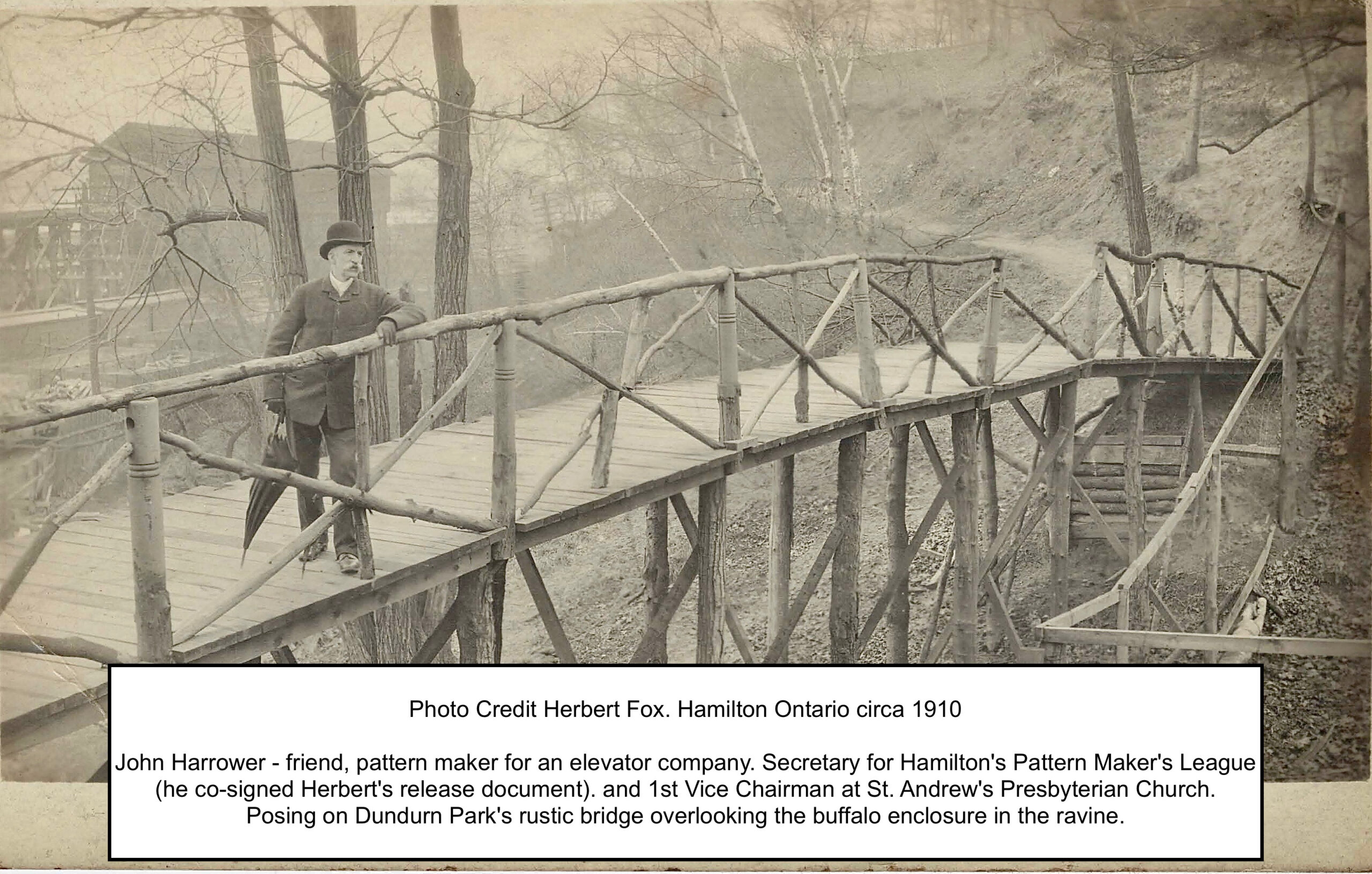
(Pausing on the rustic bridge over the ravine at Dundurn Park in the early 1900s. In the background on the left is the coaling tower used to load the steam engine tenders in the rail yard below the park. Vintage Hamilton FB Page)
"One corner of the paddock fence appears to be visible below the bridge. The gentleman standing on the bridge could very well be watching the buffalo which may help date this photo as being circa 1910. The Buffalo at the Dundurn Zoo were sent from Banff, Alberta about 1908. They resided in a paddock on the sloping area beyond the Cockpit building." Murray Aikman, Hamilton Historian - Vintage Hamilton FB Page

Buffalo at Dundurn Park are standing bottom right. Picture courtesy of Local History & Archives Department, Hamilton Public Library - posted on Vintage Hamilton FB Page
Caged Ape photo credit Herbert Fox. Caged Bears and Leo the Lion at Dundurn Park photo Credit Maria Burbidge - Historical Hamilton FB Page
"Unfortunately, the buffalo were not the most popular of animals at the zoo and through the years of W.W.I repeated attempts were made to sell them. These efforts continued into the early 1920s at which time the buffalo were costing $200.00 a month to care for. [That amount in 2020 is the equivalent of $28,250.00] Here's a quote from The Hamilton Spectator: of January 24, 1919: "...the keeping of 15 or 18 big buffaloes in a little enclosure is not only not humane but it is almost a criminal waste of food" A few years earlier in 1914 the zoo's star attraction had arrived. This was Leo the Lion but In October 1921 Leo died and the zoo was never quite the same. In 1926 a proposal was made to convert the facilities into an aviary which was approved in 1927 and was completed in 1931 following the Gould bequest." Murray Aikman, Hamilton Historian - VintageHamilton FB Page

City Centre

Market Square behind old City Hall [left]. The Sign for Grafton's Jubilee can be made out on the middle building in the background. Grafton's celebrated their Golden Jubilee in 1903 and their Diamond Jubilee in 1913. If you're not familiar with the view, you are looking east toward James. Vintage Hamilton FB Page

In the book Hamilton, A People's History (Freeman, 2001), author Bill Freeman uses the chapter 'The Electric City' to sketch the timeline of the population rise of European immigrants that settled in cramped quarters to satisfy the demands of the fast-paced growing industry at the turn of the century. Over the decades, Hamilton has continued to be a beacon that attracts its new citizens from all corners of the world. The city has benefited from this broad diversity in the workplace sector; the business sector has developed a vibrant selection of small shops and restaurants, and distinctive art and community projects.


Before and After

"Notice the strength in the ladies’ arms and the size of that child? The little wooden sidewalks behind the buggy wheels, chandelier, toys in the window (?) and look at those spotless aprons! I also notice that the horse’s feet are in need of a trim and he appears to be hard used. The man is either delivering or picking up produce but clearly has it on display for this photograph because he’s posing that big whip and could never travel with it laid out like that." S. Beech Hogan, Historical Hamilton FB Page




Herbert is standing in the middle of Garth street just at the end of Beckett drive. The structure behind is known as the coach (gate) house for the Balfour property in Chedoke Park. The coach (gate) house stands today as a private residence. - Vintage Hamilton

Waterworks and the Outskirts


Barton Reservoir on the Kenilworth Access. 1943 City Engineers map. Provided by Vintage Hamilton
The Barton Reservoir was one of the first major municipal water systems in Canada starting in 1859. It was built 57.9 metres above Lake Ontario - fed from the engine house by the beach, had an 11 million gallon capacity and pumped water with the aid of gravity down across the city. A Superintendent's residence (demolished in the 1970's) and public gardens called the Reservoir Park were built afterwards. Once the James Street Reservoir was completed, this Barton Reservoir was used as an emergency reserve up until 1958 when it was completely discontinued. The area is now an overgrown ruin returned to nature and it has been recently designated as a heritage site actively under review to become a public park with walking trails. This information was sourced from a 2018 public document from the City of Hamilton: pub-hamilton.escribemeetings.com/FileStream.ashx?DocumentId=149441 (pages 61 - 165) and includes many comparison pictures of the modern remnants beside the original reservoir structures in use.

"This amazing early 1900's image of the lower city was likely taken from Reservoir Park. The view is of the Gage farm before it became Gage park after being purchased by the City of Hamilton.
Follow the Trolly street (now Gage avenue) that angles in along the left edge and you should be able to spot Wagstaffes. Just in front of the line of trees.
The Gage family home is buried behind trees and nearly out of sight. The upper floor and chimney can be spotted. In the foreground you can see two sets of rail lines. The nearer was the main line for the TH&B railways which would pass through Stoney Creek as they climbed the escarpment. The further set was alongside Lawrence road and was used by the Hamilton, Grimsby and Beamsville Radial Railway. This electric railway operated from 1894 to 1931. The farm became a park: Purchased from the Gage family in 1918, greenhouse built in 1919 and opened as a park in 1922. The park design was made in 1920 by Howard and Laurie Dunnington-Grubb. The fountain was erected 1927. At the very bottom of the photo in the left corner you can see the top of one of the telegraph poles running along the GTR/CNR railway line running up the Escarpment to Caledonia." Vintage Hamilton FB Page.
Trains

RUNAWAY TRAIN MAKES BAD WRECK
"...The giant engine of the runaway train, a Mikado, ploughed through eight cars of the standing train and then mounted the wreckage. Fire broke out immediately, and the runaway engine and sixteen cars with valuable freight were burned and thirteen other cars were wrecked. No one was seriously hurt..."
From the Globe and Mail - courtesy of Vintage Hamilton FB Page


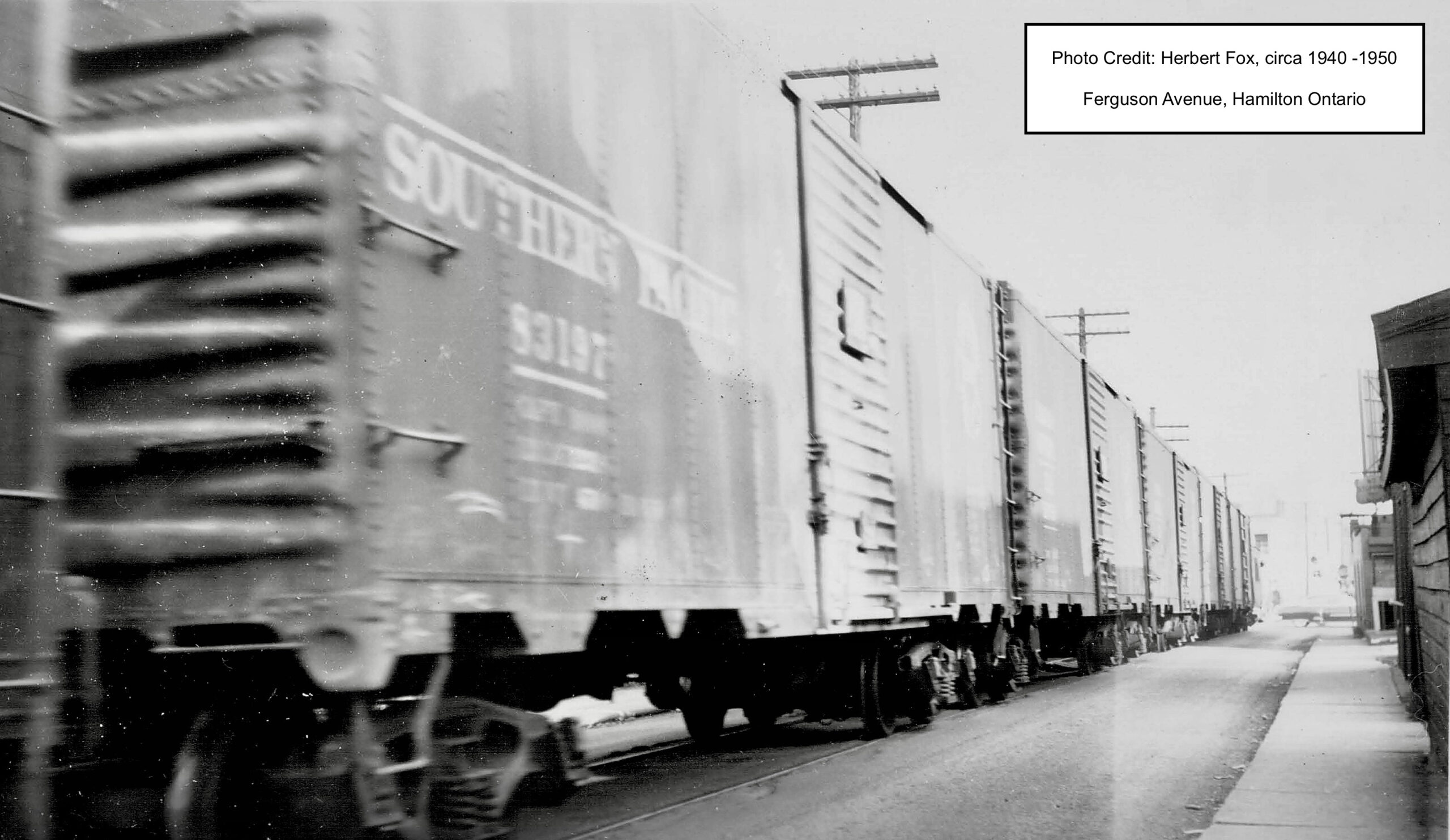
Ferguson Avenue was originally Cherry Street - the first street in Hamilton Herbert and family moved to once they emigrated from England.

"On the 18th of January, 1929, Michigan Central #8428 pulling train number 83 was involved in a serious accident along the Niagara Escarpment above Stony Creek. The roadbed under the track washed out just before the train arrived. The fireman, Mark Ricker, was killed and the engineer, Patrick Gant was seriously injured."
From thbrailway.ca/general/accidents.htm

Bookends and Waterfalls


Niagara

The collapse of the Fallsview Bridge (Honeymoon Bridge). Replaced with the Rainbow Bridge.


Royal Visit to Hamilton. Courtesey of Mr. and Mrs. H. Henry

